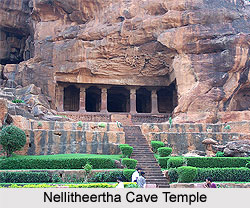 The Nellitheertha Cave Temple dates back to at least 1487 CE. The cave is situated to the right of the temple and is about 200 meters long. Access is restricted and due to the lack of a proper entrance, the visitors are forced to crawl in on their knees to peep inside the inner sanctum. Inside the cave, there is a huge lake which was formed by the water dripping from the cave in droplets in the shape of gooseberries (amla). Hence the name Nelli (amla) Theertha (holy water) came about. In front of the lake is a naturally formed Shiva Lingam, made out of pure Saligrama and has been built as Ardhanareeshwara. The temple also has shrines of Lord Maha Ganpati and Jabali Maharshi.
The Nellitheertha Cave Temple dates back to at least 1487 CE. The cave is situated to the right of the temple and is about 200 meters long. Access is restricted and due to the lack of a proper entrance, the visitors are forced to crawl in on their knees to peep inside the inner sanctum. Inside the cave, there is a huge lake which was formed by the water dripping from the cave in droplets in the shape of gooseberries (amla). Hence the name Nelli (amla) Theertha (holy water) came about. In front of the lake is a naturally formed Shiva Lingam, made out of pure Saligrama and has been built as Ardhanareeshwara. The temple also has shrines of Lord Maha Ganpati and Jabali Maharshi.
History of the Nellitheertha Cave Temple
Historically it has been recorded that this ancient Hindu temple was under the administration of the famous Chowta family of Tulu Naadu. The temple flourished under their administration and was a major centre for religious and cultural activities under their reign. There are some artefacts and archaeological evidence available at the temple which point to a Jain interest and influence at the temple. These are evidence to suggest that the temple and the region were probably under the administration of Jain kings of the region.
Interior of the Nellitheertha Cave Temple
Inside the temple there is a huge lake called the Nagappa Kere situated to the north of the temple. The lake is full of exotic wildlife; the most common among them are the snakes along-with scorpions, porcupines and thousands of bats. Visitors are asked to maintain silence inside the cave so as to not disturb the animals.
In typical Tulu-Naadu tradition, the temple also has its set of Bhootas. They are the warrior-assistants of the Gods. The main bhootas of the Nellitheertha temple are Pili (Tiger in Tulu)-Chamundi, Kshetrapala, Raktheshwari and Doomavathy. Historical artefacts like the Arasule Mancha (King"s seat), ArasuleMantapa (King"s abode) and the JinaVigraha (Jain Statue) still exists to this very day.
Legends surrounding the Nellitheertha Cave Temple
It is believed that the Sage Jabali was once tricked by an Asura
named Arunasura into giving him the sacred Gayatri Mantra, which was then being misused by the said Asura. When Maharashi Jabali learned of Arunasura"s atrocities, he was enraged and knew he had to set things right. Hence Jabali performed a penance to appease Devi Durga Parameshwari, who was pleased by his efforts and assured him that she would kill the demon Arunasura. She later took the shape of a wasp and killed him on the banks of the River Nandini. At that place today is a beautiful temple of Goddess Durgaparameshwari and the place is very well known as Kateel.
Goddess Durga also granted another wish of Jabali- that she, Lord Shiva and Lord Vishu would reside in the vicinity of the region and thus the temple in Muchur came up as the place for Devi Durga. Lord Vishnu resided in a temple in Kompavadu and Lord Shiva made Nellitheertha his abode.
Visiting information on Nellitheertha Cave Temple
The Nellitheertha Somanatheshwara Cave temple is one of the holiest temples in South Kanara and is a major tourist attraction for all its unique features. The Cave Temple stays open 6 months a year between October and April. Neelitheertha can be reached from Mangalore by reaching Yedapadavu, which is 8 kilometres from Neelitheetha or one can access the cave temple by reaching Kateel which is 5 kilometres away. Tourists can also travel through Bangalore and go through Polali and Kaikamba to reach Nellitheertha.



















